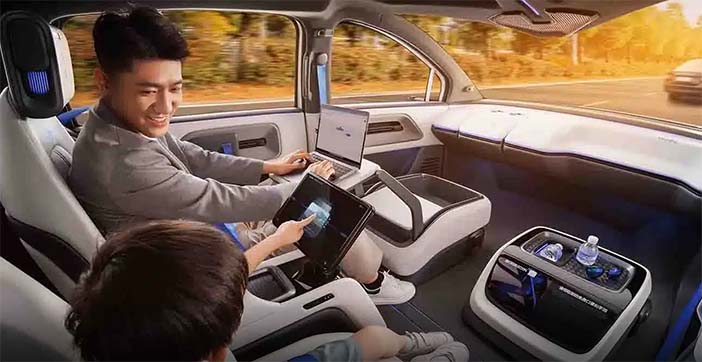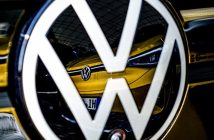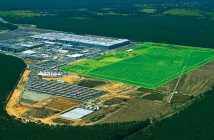+++ History has been made over the period April 1-14 as sales of new energy vehicles (NEV) exceeded half of all car sales in CHINA . New energy vehicles is a Chinese umbrella term encompassing a number of types but in reality means largely pure electric vehicles and PHEVs. Figures from the Passenger Association show that retail sales during the period were 516.000 down 11% year-on-year and down 3% month-on-month, which are not the greatest of figures. However, of these 260.000 were NEVs which is an increase of 32% y-o-y and 2% m-o-m. This makes the NEV share of sales 50.39%. Previously ,the Economist Intelligence Unit predicted that NEVs wouldn’t make up over half of sales until 2028. And the Chinese Federation of Passenger Cars only predicts a 40% penetration rates for 2024. Based on that prediction, sales would be in the region of 12 million this year. Obviously this is just the result for 2 weeks of the year but there are indications that this result will extend for the year as well. Last month Wang Chuanfu, CEO of BYD, predicted that the result would be achieved within the next 3 months. Furthermore, wholesale rates support the trend with a penetration rate of 50.19%. During the period wholesale sales were 534,000 cars up 13% y-o-y but down 9% m-o-m. Of these cars, NEVs contributed to 268.000 of the total an increase of 43% y-o-y and up 8% m-o-m. Against this background, there is a drop in the sales of ICE cars and this is being felt particularly by the joint ventures in China. Last year, SAIC General Motors sales fell be 14.5%, GAC Honda’s by 13.7% and SAIC Volkswagen by 8%. March data shows that ICE cars that in past were sales champions had rapidly falling sales with results like the Toyota Camry down by 59.2% and Volkswagen Lavida down by 36.4%. Wang Chuanfu also recently made another prediction that the joint ventures would be left with only 10% market share and this prediction from these results also seems to be playing out. +++
+++ FORD reported first quarter results that beat expectations, with its changing product game plan front and center along with its focus on petrol and hybrid offerings. Ford also boosted some guidance metrics, but not its full-year profit outlook. For the quarter, Ford reported revenue of $42.8 billion, beating estimates of $40.04 billion, and up 3% compared to a year ago. Ford posted adjusted earnings per share of $0.63 topping forecasts of $0.42, with adjusted earnings before interest and taxes coming in at $2.8 billion, compared to estimates of $2.54 billion. Ford’s results were better than those in Q4, when it was dealing with the lingering effects of the United Auto Workers (UAW) strike. Ford said full-year adjusted earnings are “tracking to high end of $10 billion to $12 billion”, though it raised its adjusted target to $6.5 billion to $7.5 billion, with guidance tightened to $8 billion to $9 billion. Previously it had projected adjusted earnings of $10 billion to $12 billion, adjusted free cash flow of $6 billion to $7 billion and capital expenditures of $8 billion to $9.5 billion. “Customers want vehicles that they’re passionate about, choices in how they’re powered, quality that’s constantly getting better and great value“, Ford president and CEO Jim Farley said in a statement. “With Ford+, we’re increasingly giving them all those things in ways that others don’t and creating a company that will lead for the long haul”. Last year, Ford divided its business into 3 units: Ford Blue, for traditional gas-powered autos; Ford Model e, for the EV division; and Ford Pro, for its commercial and super duty truck business. Here’s the breakdown for Q1: Ford Blue: $21.8 billion in revenue, earnings of $905 million; Model e: $100 million in revenue, earnings loss of $1.32 billion; Ford Pro: $18.0 billion in revenue, earnings of $3.01 billion. During the first quarter, Ford pushed deeper into its petrol and hybrid vehicles, with EV spending and production taking a back seat. Earlier this month, Ford said that it is pushing back EV production at its massive BlueOval City EV campus in Tennessee to 2026 from its initial 2025 start date. Ford also revealed it is “retiming” the launch of upcoming EVs at its plant in Oakville, Ontario, where it plans to build next-generation 3-row EVs; most likely a full-size SUV. The company is aiming to launch this vehicle in 2027, pushing back the original 2025 timeline. Ford also said earlier in the quarter it would add a third shift to boost production of its Bronco and Ranger to meet customer demand. Meanwhile, Ford is focusing on its hybrid offerings, like the Maverick and brand new F-150 with a hybrid powertrain. This was reflected in Ford’s Q1 US deliveries which jumped 6.8% to 508.083 vehicles, powered by strong sales of electrified products such as hybrids. Ford’s Maverick hybrid pickup saw its best quarter ever, with sales jumping 77% in the first quarter. Maverick also powered overall hybrid sales to a 42% jump to 38.421, with Ford claiming this was also the best quarter for hybrids and that momentum will continue. Even Ford’s EV offerings (the Mustang Mach-E, F-series Lightning EV and its E-Transit) ucked the recent trend of softening demand. Ford’s overall EV portfolio saw a massive 82% jump to 20.223 EVs sold in Q1, with the Mustang Mach-E jumping 77.3% to 9.589 units sold and the F-series Lightning pickup seeing sales surge 80.4% to 7.743 units. While the sales numbers here are strong, Ford relied on heavy discounting, cheap financing rates, and lease deals to move inventory. A down note for Ford, however, was its flagship F-150 sales. Though the F-Series (which includes the F-150 and heavy-duty F-250 and F-350 offerings) retained the crown of America’s top-selling truck, sales fell 10.2% in the quarter to 152.943 units. Ford has experienced a slow ramp-up of the all-new F-150, which started sales in March. +++
+++ One of the first questions potential buyers ask about hybrids, plug-in hybrids (PHEVs) and EVs is: “ HOW LONG WILL THE BATTERY LAST last? ”. Naysayers always quote the steep battery replacement prices as a reason to steer clear of electrified vehicles, but a recent study from Recurrent and data compiled by the government shows that you might not have to worry. This week’s Energy.gov Fact of the Week noted that plug-in hybrid batteries have shown striking resilience after the 2015 model year, with a tiny number of replacements outside of recalls. The data show that an average of only 1.5% of PHEVs have needed battery replacements due to failure between 2011 and 2023, and that number dropped to just 1% between 2016 and 2023. Features including thermal management and cooling systems have prolonged battery life, and newer internal chemistries have proven more robust than the early battery pack technologies. To clarify, the number of PHEV battery replacements was definitely higher prior to the 2015 model year. Vehicles from the 2014 model year have a 3.9% replacement rate, while those from 2013 are at 4.4%. In 2011, that number was 7.5%, so it’s better to go as new as you can afford if you’re shopping on the used market. It’s also important to note that we’re only looking at 12 years, here, and the average replacement rates might shift as more data becomes available. Additionally, this study doesn’t account for recall-related replacements, which can be annoying, even if you’re not on the hook to pay for it. The good news out of all of this is that, with a solid pre-purchase inspection, you’ll probably be in good shape buying a used PHEV. Automakers have also started lengthening warranty coverage in recent years, so if you can afford a car from 2020 or later, you’ll likely see 10 years or 160.000 km of protection against battery failures. Though this data certainly suggests recent used buyers and new buyers are unlikely to need that warranty. +++
+++ NIO ’s long awaited semi-solid state battery will finally launch on June 1; almost 2 years later than previously promised. The 150 kWh unit is the biggest capacity battery pack produced in China along with having the highest energy density. Certainly at the beginning it will only be available as an upgrade charged on a daily basis. Nio initially claimed that the battery would begin deliveries in 2022 but only finally at the end of last year were prototypes becoming a reality with CEO William Li undertaking a live-streamed endurance test in December in a Nio ET7. Over the course of 14 hours of driving at an average speed of 83.9 km/h the car covered 1.044 km. Thanks to Nio’s battery swapping technology all Nio owners can benefit from the new battery. The cost of renting is dependent on how big a battery the car was sold with. Those with 70/75 kWh battery packs will have to pay 150 yuan ($21) a day to use the 150 kWh pack. For those already with a larger 100 kWh pack the price is reduced to 100 yuan a day. Due to the modular nature of Nio’s battery swapping technology the 150 kWh unit has the same dimensions as all Nio’s other batteries. According to Nio, the 150 kWh battery pack is the world’s first soft-pack c-t-p (cell to pack) battery without thermal runaway. The battery is semi-solid state and the energy density is up to 360 Wh/kg which is the highest energy density for any pack currently mass-produced in China. It’s previously been claimed that the cost of the 150 kWh pack is extremely expensive, about the same as a whole car (Nio ET5). This is believed to be the reason why the 150 kWh is not being offered for actual purchase by customers. The battery gives Nio models a range of around 1.000 km (optimistic CLTC cyclus) and the rental means people undertaking long trip can rent a battery for a few days. Nio delivered 30.053 cars in the first quarter of 2024 and has sold 479.647 cars to date. The 2024 version of the ET7 was launched at the Beijing Auto Show. Buyers of Nio cars have the option of buying just the car without the battery and then renting the battery under a BaaS (battery as a service) agreement. In mid-March Nio brought down the monthly rental price of the standard battery pack (75 kWh) from 980 yuan to 728 yuan. Similarly, the long-range pack (100 kWh) price came down from 1.680 yuan to 1.128 yuan. +++
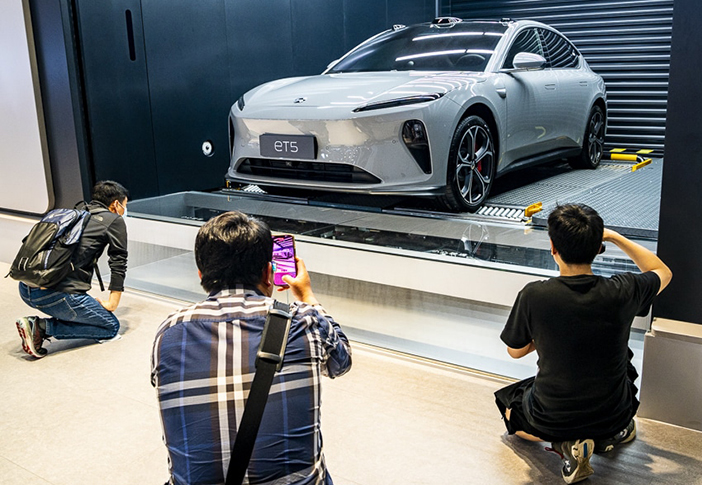
+++ A POLESTAR 5 prototype has managed to charge from 10-80% in 10 minutes. Charging rate during the test started at 310 kW and rose to over 370 kW by the end of charging. This is a world- first demonstration in a drivable vehicle, as opposed to a laboratory demonstration for individual cells. The test was carried out with a Polestar 5 prototype car fitted with a 77 kWh battery. Its aim was to demonstrate a proof-of-concept for Extreme Fast Charging (XFC) battery technology from Israeli startup StoreDot. StoreDot’s technology has an energy density equivalent to NMC cells but uses silicon-dominant cells. This means that the cells don’t need a specialist cooling system. Instead the experimental modules have a structural function which improves mechanical properties and cooling ability while maintaining or reducing weight levels. Furthermore, recyclability and serviceability are primary considerations in the pack design utilizing the XFC technology. Current graphite anodes are reaching theoretical performance limits restricting development. In contrast XFC uses a silicon based anode which allows the possibility to push both energy density and charging rate times across several more battery generations. Polestar’s test shows that the technology works with today’s DC charging infrastructure featuring chargers of 350 kW or higher. Additionally, it shows that StoreDot’s technology has a drop-in ability to integrate with existing cars. “Time is one of life’s greatest luxuries, and as a manufacturer of luxury electric performance cars, we need to take the next step to address one of the biggest barriers to EV ownership: charging anxiety. With this new technology, on longer journeys when drivers do stop they’ll be able to spend less time charging and be back on the road faster than before. In fact, that stop time will be more akin to what they experience with a petrol car today”, says Thomas Ingenlath, Polestar CEO. The Polestar 5 is a 4-door GT model due to go on sale in 2025. It should measure in at around 4.7 meters long with a wheelbase of over 3 meters. Currently the Polestar 5 is meant to deliver with batteries from Korean producer SK On and the car will be produced in China. Whether StoreDot’s XFC technology will make it to the production version remains to be seen. +++
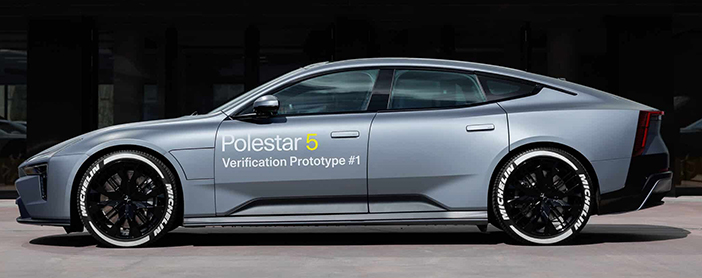
+++ Pour one out for the SUBARU LEGACY . The Japanese automaker known for its line of all-wheel-drive vehicles announced that 2025 will be the final year for the Legacy, a vehicle that started its … um, legacy (sorry) … way back in 1989. It was the first Subaru built in America at the automaker’s plant in Indiana, and it was designed specifically for the American market. Throughout its 6 generations, Subaru has sold more than 1.3 million Legacy models in the United States. You likely already know why the Legacy is on its way out, but Subaru refreshingly laid it out in a news release highlighting the end of the line for the sedan: “Though the Legacy is the longest-running Subaru model line, its discontinuation reflects market shifts from passenger cars to SUVs and crossovers and Subaru’s transition to electrified and fully electric vehicles”. The numbers bear that out, as the Legacy sold about 25.000 units last year versus more than 160.000 of its lifted, wagon-style twin, the Outback. The automaker also restates its goal of producing 8 electric models by the 2028 calendar year. The Solterra is currently Subaru’s only fully electric vehicle, and it’s manufactured in partnership with Toyota. Subaru previously indicated it would launch 3 new electric SUVs in 2026. Subaru says the 2025 modelyear Legacy will arrive at dealerships in the United Stets this spring and start at $24,895, which is the same price as the current 2024 model. These final Legacy models are part of a generation that launched for the 2020 model year, and got a mild styling and trim update for the 2023 model year. With its strong sales, there’s no reason to worry about the future of the Outback, but the smaller Impreza, available as a sedan and hatch, is in a similar position as Legacy. The Impreza sold better at around 34.000 units last year, but the Crosstrek nearly equalled the Outback with around 159.000 units sold. +++
+++ TESLA and Baidu Apollo hold exploratory talks regarding the robottaxi service launch in China and the robocar alliance, sources familiar with the matter told. “Tesla will most likely not get the permit to transfer data collected by their fleet needed for FSD training out of China to the US. Their plan B is to co-store and locally process data with us as we already have mapping license cooperation and experience with our own robotaxi service”, the person who remains anonymous as he is not authorized to talk with the media told. Tesla and Baidu, also called China’s Google, are not strangers. The 2 giants began their partnership in early 2020, and Tesla has already integrated Baidu’s navigation map into its vehicles in China. Last week, on April 28, it was also reported that Baidu struck a deal with Tesla to license its mapping service for data collection, paving the way to launch the FSD in China. The report concluded Elon Musk’s short trip to China, where he met with Chinese premier Li Qiang. Musk previously announced that Tesla is now fully focused on the launch of a fully autonomous robottaxi service and will make a major announcement on May 8. The source told that Tesla seeks to launch a fully autonomous robottaxi in China before the US. Baidu Apollo is Baidu’s self-driving project focusing on level 4 (L4) autonomous driving. On February 26, Baidu received the permit to offer robottaxi service at Daixing Airport in Beijing. On March 8, the company launched China’s first 24/7 fully driverless robottaxi service in Wuhan. With the approval granted by the head office of the Beijing High-Level Automated Driving Demonstration Area, Apollo Go can provide autonomous vehicles on the 40-kilometer expressway connecting Daxing International Airport and Beijing urban areas. In addition, Baidu’s fully autonomous driving robotaxis already operates in several cities nationwide, including Chongqing, Wuhan, and Shenzhen. Baidu claims Apollo Go is the world’s largest autonomous driving mobility service provider. As of September 30, 2023, it had accumulated more than 4.1 million ride orders. In the Q3 of last year, Apollo Go provided 821.000 rides, marking a 73 percent surge compared with the previous year. Baidu is also the first company in China to get a permit for testing driverless buses on public roads. In 2022, it unveiled the Baidu RT6 Robottaxi fully autonomous concept car. Despite the Apollo Go progress, Baidu lacks customers for its self-driving solution. The only one so far is Jiyue Auto, which launched its Robo-01, later renamed Jiuye 01, and recently unveiled the Jiuye 07 sedan at the Beijing Auto Show. However, Jiuye is a joint venture between Baidu and Geely. Baidu Apollo faces tough competition from other Chinese autonomous driving companies like WeRide, Pony.ai, and AutoX. Moreover, EV startups are developing their own solutions, such as XNGP from Xpeng, NOP+ from Nio, NZP from Zeekr, or ADS from Huawei. Partnership with a US EV giant might be a needed cheer-up for Baidu’s AV effort. Data security and regulatory compliance concerns have been significant hurdles for Tesla, which introduced its Autopilot software 4 years ago in China. However, despite strong customer demand, FSD is unavailable in this country. Since 2021, Chinese authorities have mandated that Tesla store all data gathered by its vehicles in China within the country, preventing the company from transferring any of this data back to the United States. Reports indicate that Musk wants approval to transfer the data collected from Tesla’s vehicles overseas to China. This data would be used to train algorithms for autonomous driving technologies. +++
